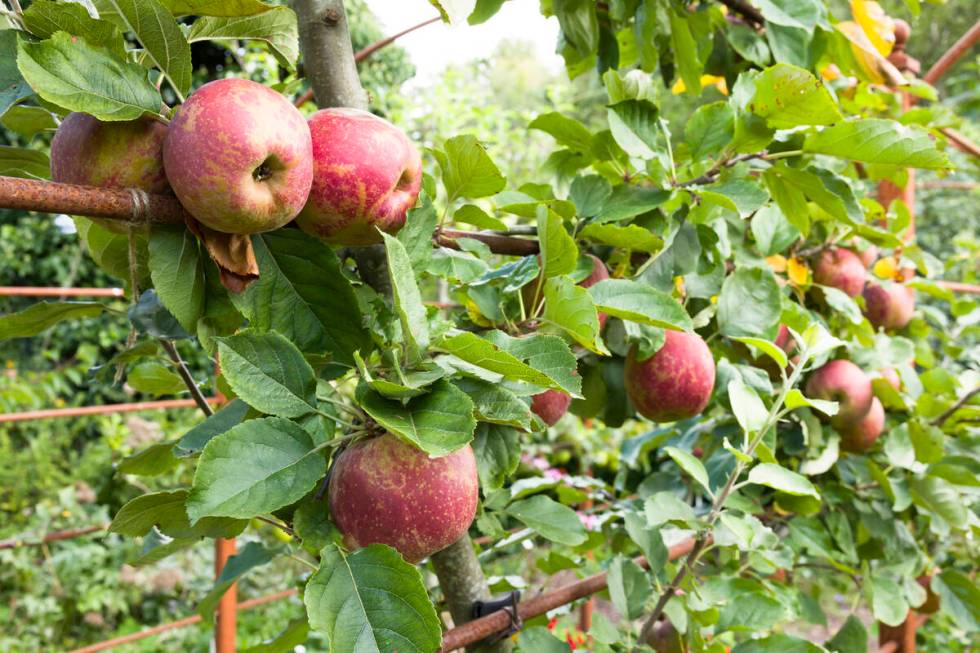Are pomegranates good candidates for espaliering?

Q: I am wondering if pomegranates might be good candidates for espaliering? I’ve loved this technique ever since visiting Mount Vernon in my senior year and Versailles a few years ago. Now that we are building a house, I would love to incorporate an espalier as well as a horizontal cordon. Are there any other recommendations for good espalier trees in our area/growing zone? (Maybe figs?)
A: Traditional espalier makes use of steel wires about 12 to 15 inches apart (enough room for the fruit) and 2 to 8 feet tall (ease of harvest). These wires are kept horizontally very tight (from 80 to 400 pounds of tension depending on the steel used). Try not to use an existing fence, but the trellis should be far enough from fencing (at least 12 inches) to reach behind it for pruning or tying.
Espalier is very similar to a grape trellis. Like grapes, they require a lot of attention (pruning, tying) when growing the branches horizontally instead of letting them grow any which way. That is not how they want to grow. Traditionally, rows of plants are planted north to south in nontropical areas.
Figs are a better choice to grow horizontally at the beginning. Later on, when you get the hang of it and the time management needed, try pomegranates. They are a bit more difficult to train in an espalier form than figs, but it can be done. Nearly any fruit tree can be grown in espalier form.
I grew an Anna apple tree in this manner near an east-west fence for several years. It was not ideal, but it could be done. Both plants, figs and pomegranates, will take the heat of full sun in our area but are best grown with other plants. Figs are not a desert tree and have the same water requirement as a peach or an apricot tree.
Buy the plant small with lower branches. When you plant, stake it. Use the same amount of soil amendment as with other fruit trees. Cover the soil with 2 to 3 inches of wood chip mulch, not bark. Plant it in the early spring.
Q: Due to the extreme heat, the leaves on my rose bushes are scorched and brown. Should I cut them back or just leave them alone once the temperature cools down? I put mulch around the base of each rose bush.
A: Are you deadheading your roses — removing spent blooms — when the flowers are no longer pretty? This practice is thought to speed up the process of making more flowers.
The scorching of rose leaves is common during Las Vegas summers. Roses are finicky about the heat. Some varieties do better than others are not. It just depends on when it occurs during the summer.
You will extend the season of non-scorched leaves by planting the repeat flowering roses on the east side of the house, so they get afternoon shade.
The trade-off is that they are a bit slower (one to two weeks) to start growing and flowering (repeat bloomers only) during the late winter or early spring on the east side compared with the south or west sides.
By late winter, I mean late January or early February in our area.
Toward the end of summer (late August or early September), just before repeat bloomers start repeating, I prune them hard enough to get rid of unsightly scorched leaves. (This does not change the pruning of them to their appropriate size in January.)
First, make sure you have the types of roses that will flower over and over again. Next, cover the soil over its roots with compost a quarter inch deep. Then water. Lastly, cover the area with wood chips a couple of inches thick.
Q: You helped me identify the problem of fairy ring on my Bermuda grass lawn. Thank you. Do you have any idea if the lawn should come back vigorously in this heat? Is it too hot to put down some Bermuda seed?
A: Bermuda grass seed is usually applied in late March or early April (it is a hot-weather plant). Normally, Bermuda grass seed is not sowed in or after July because it establishes so slowly. Cool-season grasses like fescues are normally sowed in late January, February or early March. Because cool-season grasses overwinter, they can also be sowed in the fall.
Grasses grow differently from other plants. Grasses have what is called an intercalary meristem; the newest growth comes from the stem. Grasses push new growth from the stem so that the old growth is always mowed off.
It is best to fertilize when the weather is cooler.
Q: Explain to me how 1 inch of water can go to different depths in different types of soil.
A: Plants growing in sand are watered more often and with less water each time than plants growing their roots in loam or clay soil. But plants are irrigated with the same amount of water.
Plants growing in sand are watered more often but with less amounts of water. Plants growing on clay (loam has some clay in it) are watered less often but with more water each time.
Plants use the same amount of water in both cases.
Bob Morris is a horticulture expert and professor emeritus of UNLV. Visit his blog at xtremehorticulture.blogspot.com. Send questions to Extremehort@aol.com.